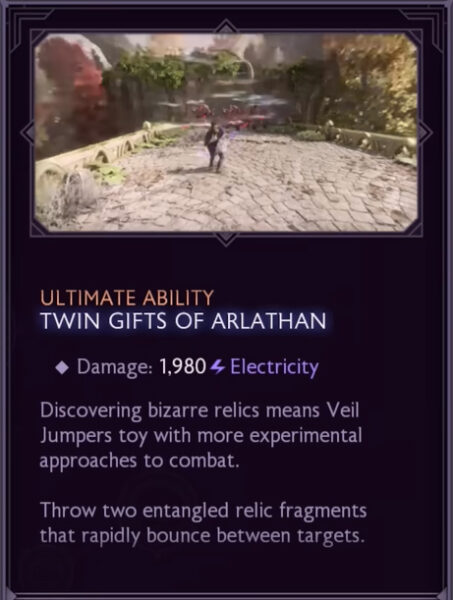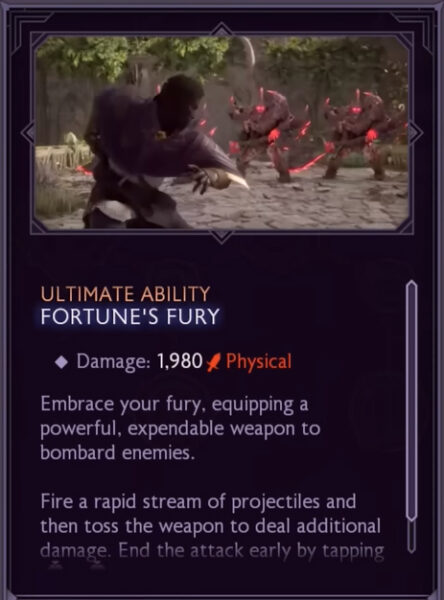The Dragon Age: The Veilguard will have some changes to the three available classes and specializations: Mage, Warrior, and Rogue. Here is what we know so far.
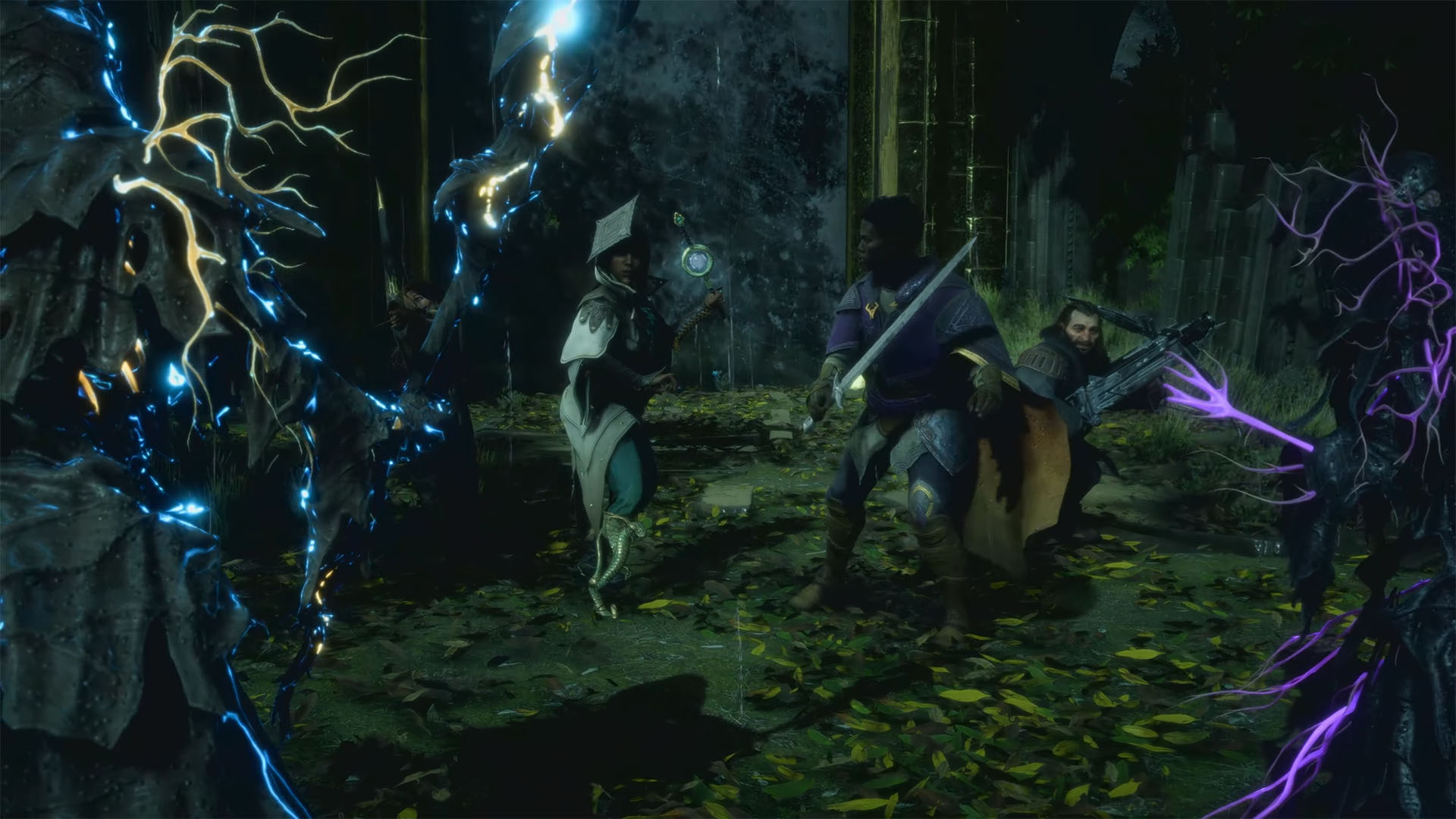
In Dragon Age: the Veilguard, your class determines your gameplay style in combat, skills, and specializations. This guide highlights what to expect from classes, specializations, and who should pick what class. Unlike previous Dragon Age games, the Veilguard will feature more action-oriented combat. Moreover, your companions will heavily influence your choice because of the combo system.
This combo system combines skills from your party to prime and detonate abilities, creating a powerful effect. Therefore, be strategic in planning out your class and playstyle. Lastly, specializations (subclasses) are selected at level 20 or higher. Each class can pick from one of three specializations, giving you a unique combat style and skills.
What is the best class in Dragon Age: The Veilguard?

The best class in Dragon Age, the Veilguard, is based on your gameplay style, companion choices, and difficulty setting. New players will want a simple and heavily survivable class like the Warrior. Rogues and Mages excel at damage but can be less durable at first. Moreover, your player-controlled character should be chosen based on the companions you intend to use. This is because Dragon Age Combat uses a combo system requiring a primer and detonator to get the most out of your skills and abilities.
Below are our suggestions on the best class depending on your playstyle:
- Mage: great for players who value powerful spells, crowd control, damage, and support at the expense of survivability.
- Rogue: the highest burst damage in the game but with lower utility and durability.
- Warrior: highest survivability and easiest to play.
The best class is one that you enjoy the most and intend to play for many hours.
All Classes in Dragon Age: The Veilguard Explored
In Dragon Age, there are three classes: Mage, Warrior, and Rogue, each with distinct skills crucial for every team. In previous games, party composition in Dragon Age included four members. However, in The Veilguard, this was downsized to three. Therefore, the best results you can get are if you have at least one of each class representation at your disposal during combat, exploration, and questing.
In Dragon Age, classes have strictly defined abilities, pros, and cons. As a result, it’s not easy to replace the benefits of each one of those classes. Consequently, it’s best to have a party that includes one Mage, Warrior, and Rogue.
All Dragon Age The Veilguard classes and specializations are listed below:
- Rogue
- Death Caller
- Evoker
- Spellblade
- Mage
- Death Caller
- Evoker
- Spellbade
- Warrior
- Champion
- Reaper
- Slayer
The Dragon Age: The Veilguard leans even more into action RPG rather than the strategy combat we saw in previous Dragon Age games.
Additionally, in Dragon Age: Inquisition, rogues and warriors must decide their starting weapon while choosing the class. The Sword and Shield or Two-Handed for Warriors. Bow or Dual Wield Daggers for Rogues. Later in the game, players can respec their points and swap to the other weapon type. However, in Dragon Age: The Veilguard, all classes will have the ability to dual wield.
Rogue

Class features – The Rogue:
- Available for Races: Elf, Dwarf, Qunari, and Human
- Armor Type: Medium
- Weapon Type: Daggers and Bow
- Skill Groups: Burst, Sustain, Control
- Specializations: Duelist, Saboteur, Veil Ranger
- Combat Resource: Momentum
Rogues are agile and stealthy, specializing in ranged attacks with bows or close-quarters combat with dual daggers. In Dragon Age: the Veilguard, the Rogue is intended as a high burst damage class that can play in melee or at ranged. The Rogue uses medium armor with daggers and a bow. Unlike other classes in the game, rogues do not use bar swaps and can activate their bow-ranged weapon upon activating a button.
Furthermore, the Rogue uses a unique resource in combat called momentum. To build momentum, you must light and heavy attack, combining multiple attacks and consecutive attacks to fill the meter. Once the meter is full, then you can use a specific ability. Therefore, you must be careful when building resources to activate powerful skills in melee or at range.
Rogue Class Specializations
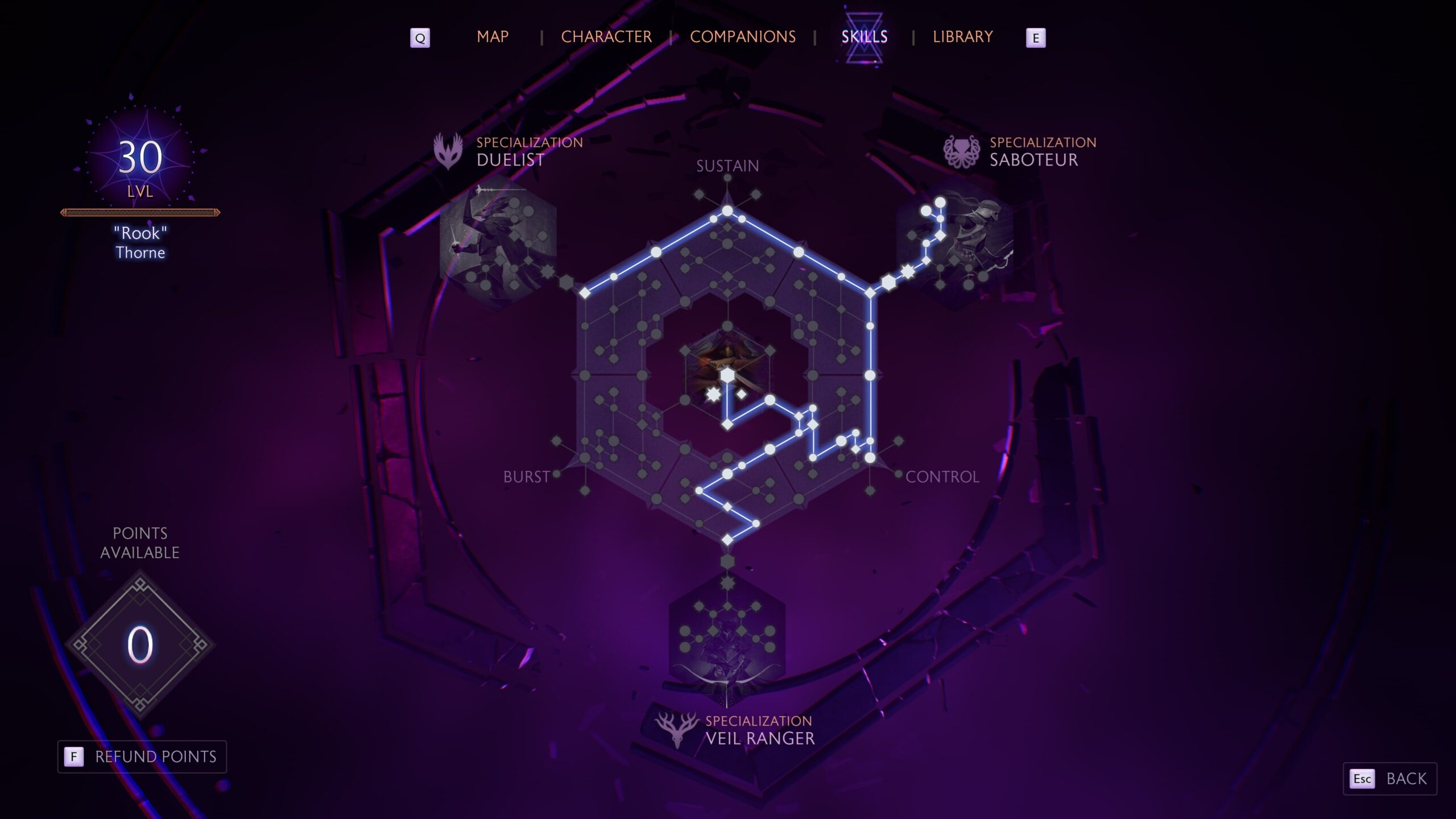
Rogue Specializations and Features:
- Duelist: Swift as the wind, the Antivan Crow Duelist specializes in dancing between blades and punishing enemies with devastating melee blows.
- Saboteur: A true swashbuckler, the Lords of Fortune Saboteur specializes in using explosives and other contraptions to weaken enemies, control the battlefield, and handle even the most dangerous situations
- Veil Ranger: Using tactics learned in Arlathan, the Veil Ranger specializes in bringing down targets with charged, long-range shots and pinpoint accuracy
The Rogue features three distinct specializations favoring different combat styles. We suggest selecting Duelist for melee DPS or Veil Ranger for players who value range DPS. The Duelist specialization is the most powerful for pure damage, gaining increased Momentum resources. Your overall gameplay and combat style attempt to land as many attacks as possible to maintain high resources while weaving in skills and abilities for the most damage. This complexity is what players will either enjoy or dislike about the Duelist.
The Veil Ranger is the best specialization for ranged bow users who enjoy aiming at targets like a first-person shooter. However, that’s also the downside of the Veil Ranger is the requirement for head and weak point shots to make the most out of your damage. As a Veil Ranger, you use a Bow that doesn’t require a bar swap like other non-Rogue classes. Thus, you can still do some melee damage, and activate your bow more frequently.
A unique specialization in Dragon Age the Veilguard is the Saboteur because it uses traps and contraptions for damage. While other classes deal direct damage and buff parties and have incredible survivability, the Saboteur expects enemies to walk into pitfalls for damage. While this can be effective in choke points, it’s an odd playstyle that is geared towards slow and methodic combat and remains unenjoyable.
Rogue Combat

The strength of the Rogue is that it plays at any range effectively, with high damage and no bar swapping. Secondly, you have a low cooldown (6-second) skill, Pifer, which grants you some healing. Therefore, this is an excellent class to pick as a primary damage dealer, that also gives you some extra survivability.
However, the Rogue can be complex in combat, requiring combos to build resources. The Rogue’s combat resource is Momentum, which increases when you land attacks and decreases when you are hit. Therefore, this means that mobility and positioning are key. You must be able to read the field of battle, moving in and out of close range as you attack and avoid being hit.
Furthermore, the bow requires aiming with headshots (weak points) for optimal damage. Additionally, Rogues can only carry a limited amount of arrows at a time. As you can see in the image above, the base limit is 8 arrows at a time. While attacking from range, an on screen notification will pop-up when you are ‘Low on Arrows’. Arrows will regenerate over time, but bow-based builds will want to have some other skills to fill the gaps.
Mage

Class features – The Mage:
- Available for Races: Elf, Qunari, and Human
- Armor Type: Light Armour
- Weapon Type: Staves, Orbs, Daggers
- Skill Groups: Burst, Sustain, Control
- Specializations: Death Caller, Evoker, Spellblade
In Dragon Age: the Veilguard, the Mage class is a versatile ranged caster who can not only inflict damage but uses support spells for buffs, debuffs, crowd control, and more. With the Mage class, when you start leveling you will likely equip traditional weapons such as staves and scepters. However, this can change dramatically later in the game, depending on your choice of class specialization.
However, effective Mage gameplay requires coordination with your companions. Choosing the right party members is essential, so that you can execute powerful combos against difficult enemies. You’ll have to carefully read tooltips and choose abilities for yourself that can apply status effects that your companions can then detonate. Or vice versa!
Mage Class Specializations

Mage Specializations and Features:
- Death Caller: With knowledge from the Necropolis, the Mourn Watch Death Caller uses forces of life and death to drain their enemies and power spells with their own life force.
- Evoker: Trained on Minrathous streets, the Shadow Dragon Evoker uses ice to control the battlefield and delivers powerful magical attacks to take down enemies.
- Spellblade: Weaving magic and melee together, the Crow Spellblade wields both dagger and orb to serve death to their foes.
The Mage specializations have three distinct playstyles. The Death Caller deals Necrotic damage and plays primarily at range. Your basic attack can be channeled into a beam, destroying targets at range without the need to play in melee range.



The Evoker Mage specialization is the cold elemental effect emphasizing staff combos and heavy attacks. The strength of the Evoker is the cold damage, slowing, pulling, and even freezing enemies in place.
Finally, the Spellblade emphasizes electricity damage in the melee range, providing powerful damage, fun gameplay, and elemental shock. It utilizes a weapon combination that includes daggers for melee strikes, in addition to your spells. What makes the Spellblade unique is the Arcane Bomb status effect. While attacking with your daggers, you debuff the enemy until they have enough stacks then explode.
Mage Combat
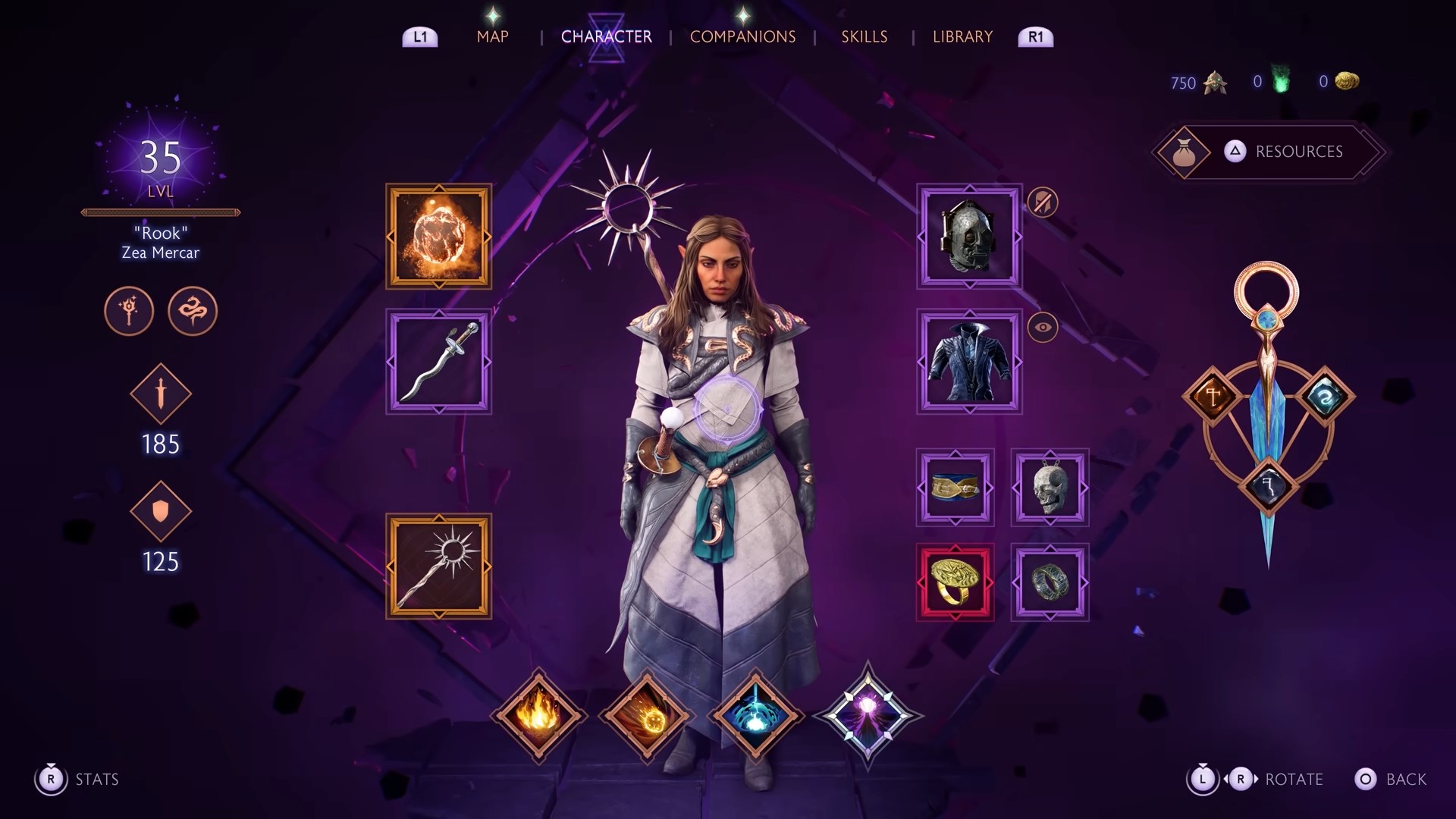
The Mage class in Dragon Age, the Veilguard, features light armor with two possible weapon sets: Staff, and Orb with Dagger. Like the other classes they also have their own unique resource that they must generate in order to use some special abilities and spells, called Mana. This resource passively regenerates for Mages, so if you’ve spent all of it on casts you will have to wait for the bar to fill again. However, you can combine the Mage class with the Shadow Dragons faction choice. Their Resourceful trait bonus will increase that regeneration speed.
Furthermore, in The Veilguard, the Mage class will now have the ability to swap weapons, opening up a whole range of combat opportunities and playstyles. However, this complexity of Mage gameplay could be frustrating for some. A Mage will have to be mobile, constantly on the move because in light armor your survivability will likely be the lowest. A Mage should always bring along at least one Warrior companion (such as Davrin or Taash) to fill the tank role.
Warrior

Class features – The Warrior:
- Available for Races: Elf, Dwarf, Qunari, and Human
- Armor Type: Heavy
- Weapon Type: Sword and Shield or Two-Handed
- Skill Groups: Weapons, Survival, Abilities
- Specializations: Slayer, Reaper, Champion
Warriors in the Dragon Age series are the frontline fighters, excelling in melee combat with swords, axes, and shields. Usually, the Warrior class fulfills the role of your sturdy and durable tank character. Like other RPGs, this class has a unique taunt mechanic that forces enemies to attack you. You want to make sure to trigger this skill at the start of battle at all times, and watch the cooldown, so that you can provide effective protection to your party.
The resource mechanic for the Warrior is similar to the Rogue, where you will generate Rage when hit or hitting a target. Once the Rage meter fills up, then you can use certain skills.
Warrior Class Specializations

Warrior Specializations and Features:
- Champion: The pinnacle of Grey Warden combat prowess. The Champion is a born leader who rallies their allies, turns their fervor into flame, and wields a shield as a deadly weapon.
- Reaper: Defender of the living and dead, the Mourn Watch Reaper leeches life from enemies, throws shields with precision, and turns their own pain into strength.
- Slayer: Reckless in battle, the Lords of Fortune Slayer specializes in two-handed weapons, breaking enemy defenses, and quick movements around the battlefield.
Two of the Warrior specializations focus on Sword and Shield, the Champion and Reaper, while the Slayer emphasizes damage and AOE with two-handed weapons. The Champion specialization is the most powerful in Dragon Age the Veilguard due to its ability to add AOE and fire damage to a powerful defensive-minded class. Moreover, the ultimate ability, Warden’s Fire, deals a massive amount of damage and applies burning to all enemies in a huge range, giving you another added benefit for playing a high survivability character.
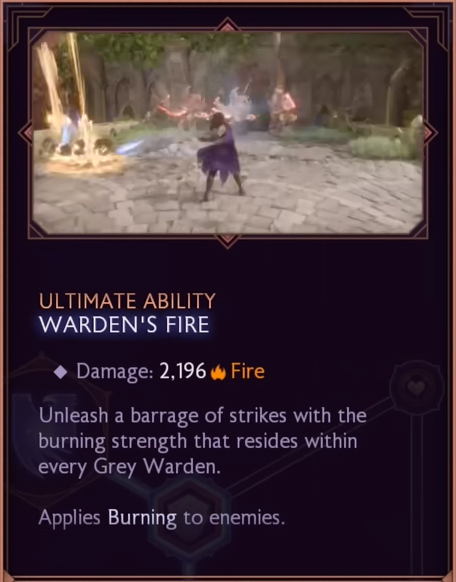
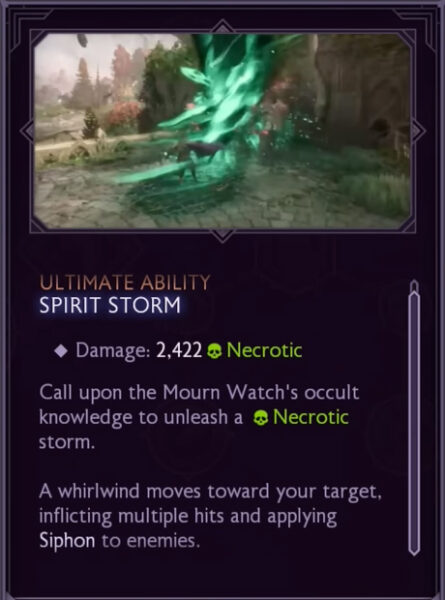

The Reaper Warrior Specialization focuses on shield throws and Necrotic damage. This class gameplay is about outlasting enemies and having more range shield throws to trigger large explosions. This style is geared towards slower pace combat tactical decision-making paramount.
Finally, the Slayer specialization is your brawler two-handed damage-dealing warrior build. The specialization has multiple gap closers and leaps with many ways to stagger and stun enemies.
Warrior Combat

The Warrior class is your high survivability tank or melee DPS class focusing on melee combat. Warriors can wear heavy armor and equip a sword and shield, two-handed weapon, or even dual wield. Their special resource, Rage, does require dealing damage or taking hits from enemies in order to fill . Consequently, this makes their bar much easier to fill than the Rogue, a class that only generates Momentum by dealing hits and looses it by taking damage. This is a fantastic system for a tank build or frontline damage dealer, as you will often be in the thick of battle.
Furthermore, the strength of the Warrior class is its high survivability, crowd control, and buffs to your party. As with any other class, you’ll get the most out of your Warrior by carefully choosing abilities and companions based on the combos you can create.
What are Skill Trees and Specializations in Dragon Age: The Veilguard?
With a level cap of 50, each level player has one skill point in Dragon Age: The Veilguard. Specializations are unlocked at level 20, which allows you to customize your build further. With three classes and three specializations per class, players can customize their build and optimize their party composition and loadout.

Rook’s skill tree features passive abilities, combat abilities, and more, and paths to three unique class specializations.
Refunding the skills and respec the character is straightforward. You simply must press the “F” key on the PC in the skill tree menu, and you can spend all your skill points again.
Other Combat Changes in the Dragon Age: The Veilguard
One of the biggest changes is shrinking the party size to 3, which feels more along the lines of Mass Effect approach. Additionally, you will no longer be able to take full control of your companions and make turn-based choices for tactical combat. Instead, the combat of Dragon Age: The Veilguard is more like action-based, real-time combat.
However, your choice of companions and their abilities will still remain a vital strategy of Dragon Age: The Veilguard. At any time during combat, you can pause the action and open up an ‘ability wheel’. This will display not only your own available abilities, but also that of your companions. It will show any available combo opportunities, which are deadly combinations that you always want to take advantage of.

These ability combos are based on the application and then detonation of status effects. For example, Antivan Rogue companion Lucanis has an ability called Debilitate. This deals Necrotic damage and can stagger enemies, but the vital info for combos is that it applies Sundered. Therefore, when you have Lucanis in your party you will want to make sure to have an ability available that detonates Sundered.
Additionally, this also works in reverse. You can use an ability to apply an effect like Overwhelmed, and a companion can use one of their abilities to detonate it.
Combat Features in Dragon Age: The Veilguard
Combat features in Dragon Age: The Veilguard Classes and party composition
- Combo Opportunity: We can see that two skills can be combined to create a “combo.” Mixing specific skills to get more powerful effects and damage was always a mechanic present in Dragon Age. However, looks like Dragon Age: The Veilguard will take it to a different level, allowing classes to increase overall party damage with clear indicators of ability combinations.
- An unknown icon not seen in any other class gameplay. It may be a warrior’s inherent ability to defend or increase defenses.
- Tap Target: Tap target is a useful detail in combat that may help you focus on a single opponent. Especially if you’re playing on a controller.
- Enemies have weaknesses and strengths: Using the correct attacks can exploit those weaknesses.
- Damage numbers: There is a setting that turns on damage dealt with each attack.
FAQs About Classes in Dragon Age: The Veilguard
Q1: Will Dragon Age the Veilguard have classes?
Dragon Age the Veilguard will feature three classes: Mage, Rogue, and Warrior. Each will have three subclasses called specializations, which start at level 20. These specializations give you additional skills and abilities to make your class feel and play differently.
Q2: What is the starting class in Dragon Age Veilguard?
You can pick your starting class in character creation in Dragon Age Veilguard.
Q3: When do you pick a specialization?
Starting at level 20, players can customize their class and build further by selecting a specialization.
Q4: What are all the available Classes and Specializations in the Dragon Age: The Veilguard?
There are three classes, each with three specializations. Players can study them to get an idea of which class they can choose according to their playstyle.
Looking For More?
Thank you for reading the all Dragon Age: The Veilguard Classes and Specializations guide We provide the latest news and create guides for Baldur’s Gate 3, Fallout 4, ARK Survival Ascended, and more. Also, watch me play games on Twitch or visit my YouTube channel!
- Dragon Age: The Veilguard – Backgrounds (Factions) Explained
- Dragon Age: The Veilguard – All Companions and Everything We Know
- Dragon Age: The Veilguard Classes and Specializations
- Dragon Age: The Veilguard – All Playable Races
- Support us at Checkout Using Promo Code DELTIASGAMING (here)
 Reddit
Reddit
 Email
Email

